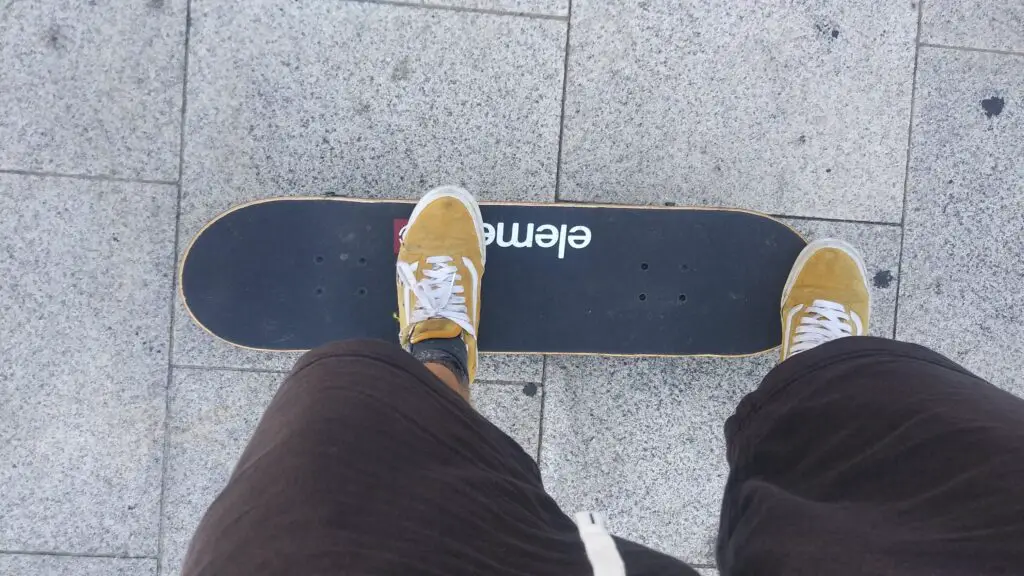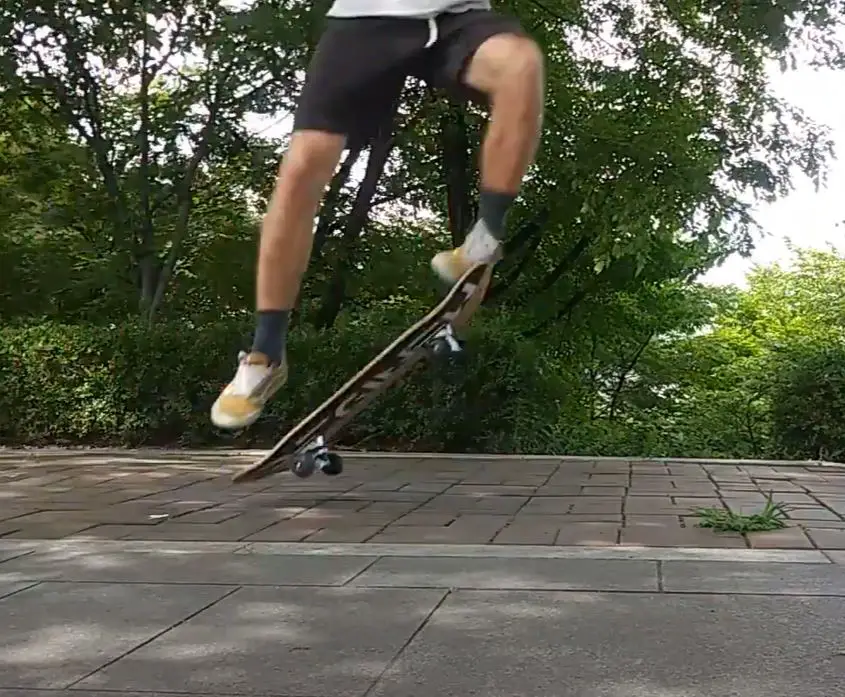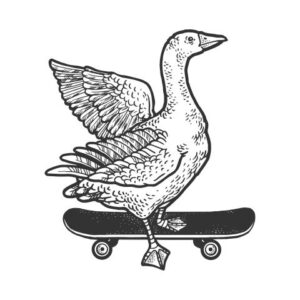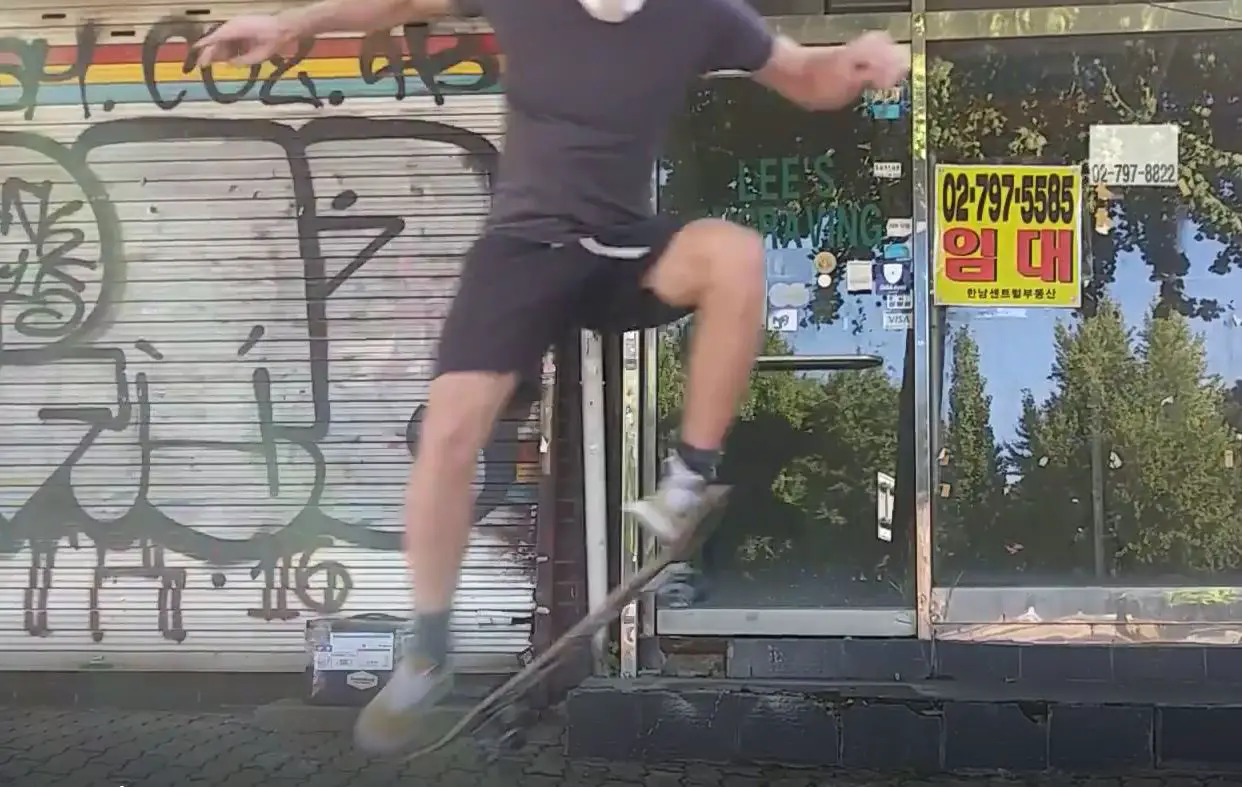There really is no point in knowing how to ollie if you can’t do it while moving.
Once you can confidently ollie while moving, so many aspects of skateboarding open up to you. You can start learning more advanced tricks. You can cruise comfortably and pop over curbs and small obstacles. The ollie is just so versatile that you need to learn it well.
Yet, learning to ollie while moving can be tricky. If you’ve learned to do it while still, then you basically need to relearn it while moving. I’m going to assume you already know the basic mechanics of an ollie including how to pop your board and slide your front foot to catch it.
This guide is how to get that ollie moving.
So let’s get into it.
How To Ollie While Moving
Start By Moving Slow
Ok, you can’t run before you crawl. You need to start off going at a rather slow pace. Not too slow that a crack stops you, but slow enough that you aren’t too afraid of falling.
I think one little push-off should be absolutely fine. You need to practice at a slow speed only at first and then slowly build up how fast you are going. Focus on mechanics and board control first.
Position Your Feet
Once you are slowly rolling forward, position your feet for an ollie. Your front foot will be perpendicular to your board and your back foot will be positioned with the ball of your foot centered on the tail.
You should already feel comfortable and confident with your foot placement from practicing a stationary ollie.

Get Ready To Pop By Crouching
Keep your head up and forward with your chest perpendicular to the direction you’re moving. Crouch slightly straight down by bending your knees. You need to get ready to jump up. If you don’t crouch, then you can’t really jump and you won’t get a good pop with your board.
Focus on your chest and shoulders while you crouch. Make sure they are centered above your board.
Keep Your Head Up, Shoulders Straight and Level, and Pop Your Board
Ok, now comes the tricky part. Actually doing a moving ollie.
The absolute biggest thing to focus on is your shoulders while you ollie. Sliding your foot and popping should be somewhat unconscious at this point as you should have practiced them ad nauseum.
Make sure your shoulders are level with the ground as you pop and your front shoulder points in the direction you are moving. Basically, just imagine your shoulders don’t move at all, because they shouldn’t.
Pop your board down hard and keep those shoulders level and you’re golden. The moving ollies will come naturally. It is common for people to lean back as they practice and they struggle to catch their board and land a clean ollie. Just focus on your shoulders and everything else will come into place.
Ride Away
Come down evenly with both feet and bend your knees a bit as you make impact with the ground. If you land with your back foot slightly first, you can still ride away. If you land with your front foot first, then you’ll likely fall.
If you are curious to see a data-driven breakdown of how long it takes people to learn to ollie, check out my guide here.
Common Problems
An ollie is actually a very complex trick and there are lots of areas where you can go wrong. Let’s look at a few of the common mistakes people make. I have a more in-depth guide on common ollie mistakes that I will link at the end of this section.
Leaning Back Too Much
This is a very common problem when transitioning into a moving ollie especially if you are practicing on a slightly slanted or downhill surface.
The body naturally wants to protect itself so you lean away from the perceived danger which in this case is the ollie and concrete in front of you. Unfortunately, when you lean back you can’t catch the board properly to lift it up and you also can’t land properly causing you to land on your back foot first.
Solution
Focus on keeping your shoulder even (parallel) with the surface you’re skating. When you ollie, your shoulders shouldn’t come up or ever stop being level with the ground. It can help to imagine leaning forward or leaning into your ollie.
If you have learned to drop in already, you know that you need to “lead” your board with your front shoulder. Focus on your shoulders as you pop. Keep them level and your front shoulder down.
Turning Your Board
Turning your board is another consequence of your body naturally wanting to protect itself from perceived danger. In this case, you are unconsciously trying to “face” the perceived danger by turning your body to face it.
This is another extremely common problem that beginners do even while doing an ollie stationary. It is even more likely to happen while moving. If I’m going very fast, I can still do this subconsciously.
Solution
Again the solution is to focus on your shoulders. Shoulder control is board control really. Imagine that your front shoulder is leading your skateboard and focus on keeping your front shoulder pointing in the direction that you are moving.
Not Popping Hard Enough
Sometimes you can struggle with catching and leveling out the board because you aren’t really popping it enough. This can lead you to look pretty silly and jump without your board following or even coming up at all.
Sometimes not popping hard enough can just lead to ollies that just aren’t very high.
Solution
Crouch down enough that you can explosively jump up. Remember that the “popping” motion is my flicking the ball of your back foot down and that your board’s tail will bounce against the ground. You are not jumping off of the ground at all.
Crouch and pop hard with a strong flick of your back foot.
I go a bit more in-depth on each problem and the solution in another article if you want to read more about common problems people have.
How to Stop Looking Down While Doing An Ollie
Almost everyone learns how to ollie while looking down at their board. This helps them visualize what they are doing right or wrong. Yet, once you start to ollie comfortably, looking down makes you look like a beginner and less natural on your board.
To stop looking down while you ollie, you simply need to practice looking forward with your head up as you ollie. Looking at your board doesn’t give you better board control. You can ollie perfectly fine by focusing on your shoulders and feeling the board beneath you, but this takes practice. It can actually be easier to have good form with your ollie when you stop looking down.
During your next skate session practice keeping your head up and looking forward. You might be surprised at how quickly you can learn to ollie in this way. If you already can ollie comfortably, then you will likely learn to keep your head up in just a session or two.
Is It Easier To Ollie While Moving?
This could be a matter of opinion, so keep that in mind with my answer.
It is easier to ollie while moving from a pure mechanics standpoint. The momentum of moving forward makes it easier to catch and level out your skateboard after you pop your board. However, doing an ollie while moving is mentally more difficult. Skaters can be afraid of trying to ollie because taking a fall with some speed is much worse than falling while stationary.
Even if you aren’t consciously afraid, your body often unconsciously prepares for the danger causing your shoulders to turn or you to lean back. So in this sense, doing an ollie while moving might be considered more difficult.

If you are having a problem doing an ollie straight, then check out my in-depth guide on how to stop turning while you ollie.
How Do You Get Comfortable Doing An Ollie While Moving?
This might not be the answer that you’re looking for, but the answer is practice. It’s always time and practice.
To become more comfortable while doing a moving ollie, you need to spend a considerable time practicing your ollies while moving. Only after time and practice will your moving ollies feel natural and comfortable. There is no shortcut other than to practice frequently and focused on doing your moving ollies.
My personal suggestion is to exclusively practice ollies while moving until you can consistently land about 4 out of every 5 attempts. Don’t worry so much about form here. Typically form will naturally develop over time if you consistently try to improve.
Once you can land them consistently move on to learning other tricks but do ollies every time you go out and skate. Eventually, they will become second nature to you. You will learn to crouch down to pop large and high ollies, and how to just barely pop your board to hop a small curb.
Learn by doing.
Should I Learn An Ollie While Moving?
I am someone who learned to ollie stationery first and then had to relearn to ollie while moving. If I could do it again, I would have just started by trying to learn a moving ollie.
You should learn to ollie while moving because if you learn to ollie while stationary then you will need to relearn it while moving. Once you can ollie while moving, you will virtually never do an ollie while standing still anyway. You will practice more effectively if you learn to ollie while at least slowly rolling forward.
If you are an absolute beginner, you can practice the foot slide motion while stationary, but only try an actual ollie while at least slowly moving forward.
If you want to learn how to ollie up and down a curb, then check out my guide here.
Additional Resources
Hopefully, this helped you out with getting your ollies while moving, but just in case you need more firepower, here’s a list of great ollie learning resources.
Conclusion
Doing an ollie while moving seriously takes some time. It’s common to thing that an ollie is a simple trick, but it’s really not. An ollie is a complex set of motions and it is easy to make a mistake. It is only “easy” after loads of practice.
Try and follow along with my guide and problem troubleshooting and see if that gets you going. I wrote this not as an expert, but as someone who struggled with and eventually learned to get consistent ollies.
Hopefully, my guide helped you learn what to focus on. If you don’t remember what to focus on, it’s your shoulders. Always focus on your shoulders unless you’re so new that you can’t slide your front foot.
Anyway, thanks for reading, and look out for more content and guide from Board and Wheels.



